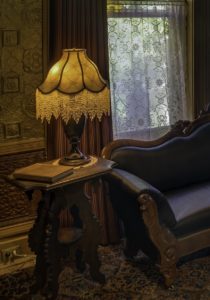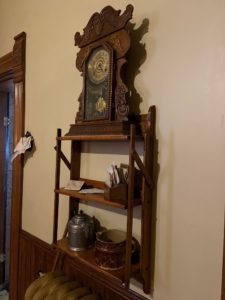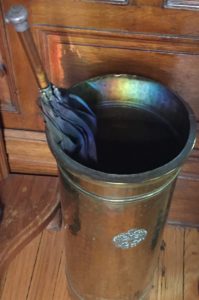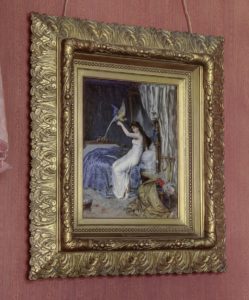Simply visiting the Molly Brown House Museum is one way you can learn about Margaret “Molly” Brown’s incredible life, however, to gain a deeper understanding of how she lived and even what she held dear, you can view her private collections, The Brown Family Collection, online on the museum website. Looking into Margaret’s life, she did not always live in such grandeur. Margaret and J.J. once lived in a very modest home in Leadville, CO, the small mining town near the famous mine where J.J. Brown struck gold and gained his wealth. You can see how drastically their lives changed by comparing possessions from their time in Leadville to their time in Denver, all of which are part of the Brown Family Collection and are on display at the Molly Brown House Museum.
The museum has very little from the Brown’s time in Leadville. According to their records, the Brown’s gave away most of what they had from their Leadville home upon moving to Denver where they purchased all new and more lavish items to furnish their mansion. However, several items that were donated back from their Leadville residence allow us to paint a story of their life during that period. The Leadville residence is no longer standing, but we do know this was a very modest residence, especially compared to their Denver mansion. There was definitely a reason why she gave away the simpler wooden furniture and replaced it with specific items that showcase her wealth and social status.
Two collapsible and space-saving pieces of furniture from Margaret and J.J.’s time in Leadville tell a story of modest means and mobility. I found these particular items interesting because they show that perhaps the couple had little room within their small home for larger furnishings. J.J. would carry some of the furniture into the mine, so having something that was collapsible and easy to carry was important to them during their time in Leadville, CO.

Courtesy of Tom McClure Photography
 The first item is a wooden table with wooden cut-out seahorse legs. This was originally owned by Margaret and J.J. Brown and had furnished their home in Leadville. This is a very modest table with stained wood and a removable tabletop which allowed this to be collapsed and transported within the mines of Leadville. However, the seahorse legs are very out-of-place and something most people have never seen before—and because of the fact that it is missing a “maker’s mark,” little is known about its manufacture. This is such a unique find that it was featured in the March/April 2000 issue of American Woodworker Magazine in which a master carpenter analyzed the table and created blueprints so that people could copy this unique woodworking piece for themselves. Once J.J. Brown struck gold and gained his wealth, Margaret and J.J. moved to Denver and gifted this table to J.J.’s brother, J.K. Brown, along with other furniture, including an ingenious, collapsible, wall-mounted shelf unit. It seems as though Margaret wanted to replace the old furniture with brand new furniture in order to furnish their new mansion, this modest but interesting and practical table was left behind and replaced with more grandiose pieces to showcase their wealth and status. However, this table is still an interesting piece of Late Victorian furniture. Another example of Late Victorian Furniture and something that was simplistic and easily stowed away, is a collapsible wooden shelf, now seen in the kitchen of the home, which was original to her Leadville home. This shelf folds out of the wall and provides ample storage, but can be easily stowed away when not in use and more room is needed.
The first item is a wooden table with wooden cut-out seahorse legs. This was originally owned by Margaret and J.J. Brown and had furnished their home in Leadville. This is a very modest table with stained wood and a removable tabletop which allowed this to be collapsed and transported within the mines of Leadville. However, the seahorse legs are very out-of-place and something most people have never seen before—and because of the fact that it is missing a “maker’s mark,” little is known about its manufacture. This is such a unique find that it was featured in the March/April 2000 issue of American Woodworker Magazine in which a master carpenter analyzed the table and created blueprints so that people could copy this unique woodworking piece for themselves. Once J.J. Brown struck gold and gained his wealth, Margaret and J.J. moved to Denver and gifted this table to J.J.’s brother, J.K. Brown, along with other furniture, including an ingenious, collapsible, wall-mounted shelf unit. It seems as though Margaret wanted to replace the old furniture with brand new furniture in order to furnish their new mansion, this modest but interesting and practical table was left behind and replaced with more grandiose pieces to showcase their wealth and status. However, this table is still an interesting piece of Late Victorian furniture. Another example of Late Victorian Furniture and something that was simplistic and easily stowed away, is a collapsible wooden shelf, now seen in the kitchen of the home, which was original to her Leadville home. This shelf folds out of the wall and provides ample storage, but can be easily stowed away when not in use and more room is needed.

Courtesy of Jody Pritzl
Though the above-mentioned items seem to be very modest, their taste in quality furnishings and unique pieces grew into a fine collection when they came into their wealth. The Browns loved to travel the world and seemed to enjoy collecting objects that represented the countries they visited. Though these items had a practical use, they showcase unique styles and social status that the earlier furnishings in Leadville may have lacked. The first item that showcases their travels and important social relationships is a hammered brass umbrella holder bearing the Romanov family crest on the outer wall. Margaret received this item directly from the Russian royal family. She was close personal friends with Princess Stephanie, who married into the royal Russian family, traveled to Russia on several occasions, and hosted Princess Stephanie in Denver as well. Margaret most likely received this during one of Princess Stephanie’s visits. Not only does this item showcase the places to which Margaret traveled, but it bears the symbol of a royal family, truly a statement piece and something that shows her visitors that she belongs in the upper class. This item is thought to be from circa 1890-1910.
The last piece I would like to showcase from this collection is an original oil painting by French painter, Charles-Alexandre Coëssin de la Fosse. This painting in Margaret’s collection is located in the front parlor of the house and was acquired during a visit in Venice, Italy.

Courtesy of Tom McClure Photography
These few items speak volumes about her shift in social status and class that occurred within a matter of a few years. Going from simple wood furnishings that collapsed to be stowed away in a small space or carried into a mine to extravagant and rare items from Venice, France, and Russia; this tells the story of Margaret’s want and need to fit into upper class society and to showcase her wealth and good fortune and leave the past behind. It is amazing how much stories and connections are able to be realized when looking into even one object from someone’s personal collection. From just a few objects we are able to better understand the Brown’s life in Leadville and how this shifted once gaining their wealth and moving to Denver.
By: Jennifer Pelache, MBHM Intern

